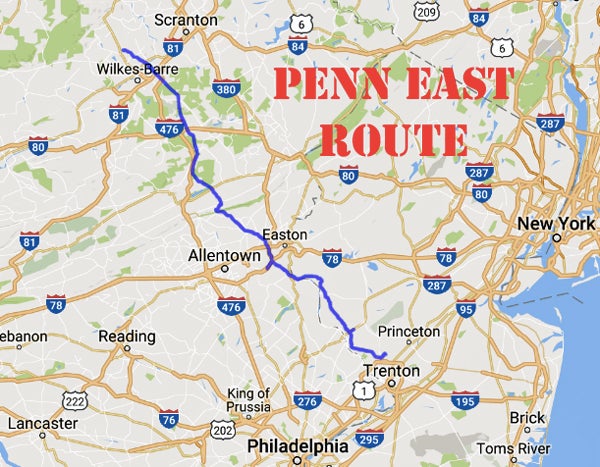Several governmental agencies raise concerns over PennEast project

(Image from PennEast Pipeline Company
Several government agencies have questioned the need for and significant aspects of the PennEast project, a new 118-mile natural-gas pipeline already facing wide opposition from residents of New Jersey and Pennsylvania.
The comments from state and federal agencies repeatedly decry a significant lack of information and unanswered questions raised by the draft environmental impact statement issued by the Federal Energy Regulatory Commission (FERC) earlier this summer.
The response by the government could trigger new delays in the $1.1 billion project, one of more than a dozen that have been proposed in New Jersey since cheap natural-gas supplies have been exploited in Pennsylvania and neighboring states. The new wells have driven down heating costs for consumers and manufacturing costs for businesses.
In separate comments, the New Jersey Rate Counsel said the project failed to demonstrate the need for a new pipeline to deliver gas to customers, saying the venture seems to be motivated more by profit than by demand.
The U.S. Environmental Protection Agency’s Region III office concluded that the project “results in significant adverse environmental impacts,’’ including possibly mobilizing naturally occurring arsenic into groundwater. Like other agencies, the EPA also said a significant amount of information is omitted from the draft EIS.

See detailed view of the pipeline route
To project opponents, those concerns raise doubts whether several key environmental permits could be issued for the project without answering ways to mitigate adverse impacts to forests, wetlands, and the 255 waterways it would cross.
Other agencies weighing in with negative comments on the proposal included the New Jersey Department of Environmental Protection, the U.S. Fish and Wildlife Service, and the National Park Service. Among other concerns, several agencies questioned why the draft EIS gave short shrift to the “no action’’ alternative.
Critics of the project were elated by the government’s response. “These agencies are clearly signaling that, as it stands right now, these projects would not be approved,’’ said Tom Gilbert, campaign director for the New Jersey Conservation Foundation.
The comments from the New Jersey government entities were surprising in that the Christie administration has put a priority on expanding the energy infrastructure in New Jersey, incorporating the issue into its Energy Master Plan.
But Rate Counsel Director Stefanie Brand and her agency’s consultant were particularly opposed to the $1.1 billion project, saying the developer failed to demonstrate the project is needed and is unduly generous to PennEast and unfair to consumers.
Rate Counsel’s argument that the project is not needed to deliver gas to consumers echoes a recurring criticism from opponents who have long argued the region can meet gas demand even on the coldest days without the project.
But PennEast countered that the project is 90 percent subscribed, which speaks for itself, according to Pat Kornick, a spokesman for the company. As for the concerns raised by the agencies, Kornick said obtaining such input is an expectation of the regulatory process.
“As PennEast proceeds through the FERC process, PennEast will continue to provide FERC with all necessary information,’’ Kornick said.
If the project moves forward, PennEast and its sponsors — including all four New Jersey gas utilities — will earn a 14 percent return on equity, well above the more traditional range of 8 percent.
“In this financial environment, the opportunity to receive a commission-regulated return of 14 percent is tantamount to winning the lottery,’’ Brand wrote. “NJ Rate Counsel is concerned that this opportunity may be a key motivating factor behind the project.’’
In its comments, the NJ DEP cited concerns with the project’s impacts on high-quality streams in the state and lack of proof drilling would not impair them. The DEP said of the draft EIS that “by no stretch of imagination can it be considered an ‘engineering and environmental anaylsis,’ ‘’ adding that portions of the report were “disingenuous’’ and “insulting.’’
The state agency repeated its caution to PennEast to avoid filing permit applications until all required information is complete. The project needs several crucial environment permits from DEP, which critics believe will be hard to obtain given the current data.
__________________________________________________________
NJ Spotlight, an independent online news service on issues critical to New Jersey, makes its in-depth reporting available to NewsWorks.
WHYY is your source for fact-based, in-depth journalism and information. As a nonprofit organization, we rely on financial support from readers like you. Please give today.




